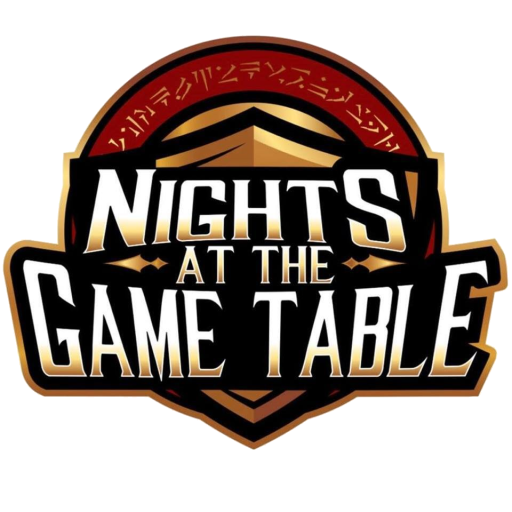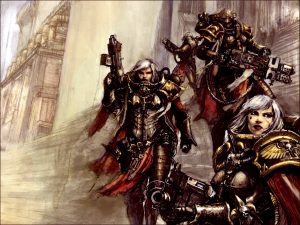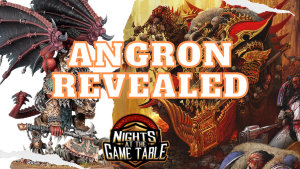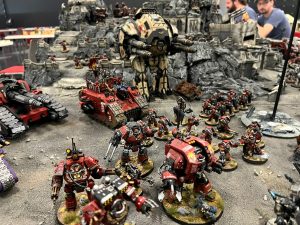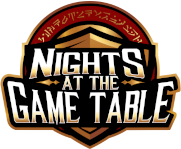Don’t blame the dice. This is something just about every good player I’ve ever talked to or heard talk about improving the game has said at some point. It’s often the first lesson told to someone looking to up their game, and it’s one that for most of us, has to be repeated over and over, because an excuse we all can fall back to so easily:

I just needed a 4” charge and I tie up his guns, wipe out his backfield, grab the objective, and win the game.
If I make 3 out of 6 2+ saves my warlord lives and swings back, killing his last model.
My dice were terrible, I should have killed his big unit but instead only did a single wound!
Particularly in the aftermath of a emotional or baffling loss, it can be extremely hard to look beyond the dice roll that upended your gameplan and see where you messed up along the way that made your game hinge on the unpredictable roll of the dice.
For this week’s article, I am going to draw from my own recent experiences at a tournament so we can discuss concrete, real world details of what caused me to lose a game. Specifically, I want to look at my round three tabling and 0-point loss at the hands of a Necron list featuring a pair of Tesseract Vaults, a Pylon, a Cryptek, 6 Destroyers, and two minimum units of Scarabs.

To set the scene, and some backstory – I have been playing competitively at large regional and national tournaments for six years now. The army I brought to the event was a balanced Tyranid list featuring three flying Hive Tyrants, four Carnifexes, a large unit of Genestealers, and a large unit of Hive Guard. As a whole, the army is extremely resilient and has the potential to put out a lot of mortal wounds and high quality shooting.
For the game in question, the mission primary was five player placed objectives, scored end game. I had the misfortune of only getting to place two of the objectives and then having my opponent able to choose deployment side. We rolled up Vanguard Strike deployment and my opponent was able to put me into the one corner of the board without an objective or a significant line of sight blocking ruin.

In his deployment, my opponent placed his Pylon in his corner by one objective, with the Destroyers hidden behind it. The two Tesseract Vaults deployed on the line, prepared to go around either side of the center ruin.

Meanwhile, I deployed mostly forward, with a screening blob of hormagaunts along the front line, and all my monsters tucked away to hide from the Pylon by keeping the tall center building between them and it.

After deployment, I lost the roll to go first, and failed to seize the initiative. In his first turn, the Cryptek used the Veil of time to jump the Destroyers forward to gun down my Hive Guard. Meanwhile the Vaults moved up on either side of the ruin and spat out some mortal wounds and wiping out the hormagaunts with their shooting. Lastly, the Pylon could draw line of sight to one Carnifex and promptly deleted it.
In my first turn I did 18 wounds to one of the Vaults, and that was about it. In return I lost a flyrant and another carnifex. Then in my turn two I brought in my Genestealers in prep to charge the wounded vault, moved up, and saw my dice just go ice cold while my opponent’s were hot. I allocated enough shooting, psychics, and combat to, by math, do about another 18 wounds to the damaged Vault, when only needed to do 6. I was actively overcommitting to killing off the damaged Vault. And then I did 3 or 4 wounds. Then, to wrap out the turn, I had a flyrant shoot and charge the cryptek resulting in exactly 0 wounds.
From there, I was tabled in short order, leading to one of the most crushing defeats I’ve suffered. After the game, my opponent and I discussed where I went wrong, and noted the vastly different dice luck in my second turn. He pointed out, in that same turn, I had done some damage to his Destroyers, and I should have focused on wiping them out, as three of the four I killed got back up in the next turn. It definitely would have helped, and would have gotten me on the board as they were part of my secondary, but I don’t think it would have allowed me to win the game.
It was easy to just blame the dice. If my second turn goes better, not even average but just not horrendously below average, I should kill one vault and the cryptek, meaning he is much less likely to get more than one Destroyer back in his turn and has significantly reduced output. After his turn three, I would still have a flyrant, genestealers, and two carnifexes in position to then tackle the remaining Destroyers and Vault, which I can then wipe out or nearly so in my turn three.
But it’s a dice game. That’s not what happened. That plan relied on making a moderately difficult charge of 8” and doing damage with a low number of strong attacks prone to high variability. So what did I do wrong? Where did I make my mistake?
The answer is in deployment. I had an extremely limited amount of practice, and most of it was with a more combat-oriented version of the list. My regular sparring partners both played lists that did most of their damage in long range shooting. As a result, my default game plan is that I must be the aggressor to close quickly and remove the ranged threats.
In game three of the day, I defaulted to this aggressive gameplan, deploying forward to maximize my turn one threat and push forward. In this, I totally ignored what my opponent’s list does and needs to do. The longest range in this army, outside the Pylon, is 24”. The Vaults do all of their damage at 18”-24” and only move 8”. The Destroyers can teleport anywhere on the board, but still have to land 9” away from my models.
All this adds up to the fact that I played right into my opponent’s plans by deploying aggressively. Let’s take a look at just a slightly different deployment that would have served me much better:

The biggest differences here are:
- The Hive Guard are deployed 15” behind the front line of Hormagaunts
- The Genestealers are deployed on the board, 32.5” from the Vault on the left – out of range unless he advances, and then, with the Kraken Opportunistic Advance stratagem, are looking at about a 4” charge if it comes forward
- The flyrants are also shuffled back just a little and the Carnifexes would be moved just a bit to remain forward while making sure every one of them was hidden from the Pylon
With this deployment I am not relying on going first, and in fact, actually want to go second; the mission objectives are all end-game and I have time to get there and with bottom of turn, can rush and stretch onto objectives at the end of the game if at all needed.
Now, going first, my opponent can either do more or less exactly what he did, move forward and jump the Destroyers up, or he can hang back, waiting for a better target to be presented. If he jumps forward, he kills possibly two Carnifexes, maybe damaging a flyrant, and wipes out my line of hormagaunts. In return, my Hive Guard should wipe out his Destroyers, shooting twice to accomplish the task if needed or start tacking damage on the Vaults. Meanwhile the Genestealers and Flyrants can jump on one Vault and cripple or kill it.
Alternatively, my opponent sees this trap and hangs back. In response, I push the hormagaunt front-line forward to the middle of the table, drop in Rippers to fill the gaps in my Deep Strike denial coverage, and keep my valuable units 15” behind the front line. The Carnifexes can move forward, putting fire into a vault while hiding from the Pylon and the Flyrants can jump into the center building – staying out of sight of the Pylon and dominating center control of the board.
Either way, by just correcting my gameplan and deployment before we even start really rolling dice, I could have taken a much stronger position and control of the game.
In this example, regardless of my opponent’s playstyle his list demands aggression. It’s largely blunt instruments designed to deal punishment and take it. It’s biggest weakness is range. The Pylon, as long range support, covers this up a little, but with the large center blocker, I can mitigate that immobile unit, reducing his list to short ranged damage from the two Vaults and the Destroyers. Additionally, outside a one-time redeploy, his list is not incredibly mobile.
Meanwhile, I also needed to better analyze my own list. I was playing it here as a Warboss – aggressive and reckless, because that’s how I could get the most out of previous iterations that lacked most of the shooting from the Hive Guard and Carnifexes. The actual list is more suited to a trap-door spider style that rewards an Archon or Changeling approach to the game. Playing into the strengths of my list to mitigate damage and set traps would have lead me to deploying more conservatively and put me in a better position to control the game, even from my back corner.
Wrapping up this example, this game had a very clear and tilting instance of dice luck. However, if that is ever the only takeaway from a loss, you aren’t really learning anything from it. Sometimes you have to rewind decisions all the way to the beginning of the game and deployment to uncover where you went wrong and uncover what to correct to improve your play. Utilizing the principles and concepts we’ve covered in the past, you can help identify where you made mistakes, be they in target priority, movement, deployment, or even unit and army categorization.
